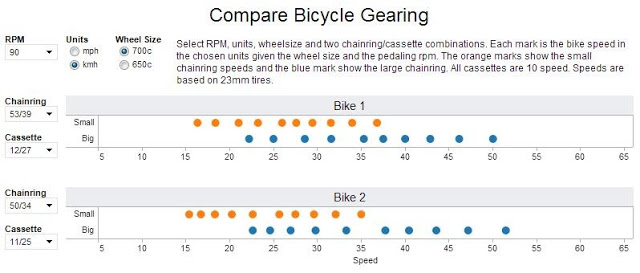Cycling is a conservative and dogmatic sport. At the highest level, the pro peloton is slow to embrace technical innovation, often preferring the tried and true over the latest and greatest. This mindset seems to filter down to all levels of cycling.
Triathletes, on the other hand, are usually eager to whip out their wallets for every trendy or newfangled product. They are unencumbered by the traditions and mores of cycling, perhaps a consequence of the relative youth of their sport. Compression gear? Hologram bracelets? Seat leashes? Hell yes, I’ll take three! While this tendency sometimes leads triathletes astray, being open minded has its advantages.
Compact cranksets are becoming increasingly popular, a trend driven not only by aging baby boomers and the rise of recreational cycling, but also by a growing number of competitive athletes realizing their benefits. While compacts are sometimes derided by self-professed “serious cyclists”, some of the world’s best have put compacts to great use. The cycling industry has warmed to compacts, with ever more crankset models and compact-specced bikes available.
After realizing how much I loved the compact on my utility/adventure/cyclocross/commuter/gravel bike and crunching some numbers, I made the switch to compact on my triathlon bike. In this post, I hope to convince you that compact cranksets merit consideration from cyclists and triathletes of all levels, from beginners to weekend warriors to pros. Compacts definitely aren’t for everyone (more on that later), but I believe that the majority of cyclists and triathletes could improve their performance and enjoyment of the sport by making the switch.
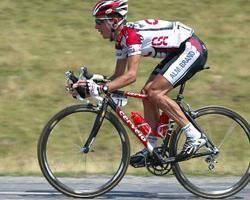
What is a compact crankset?
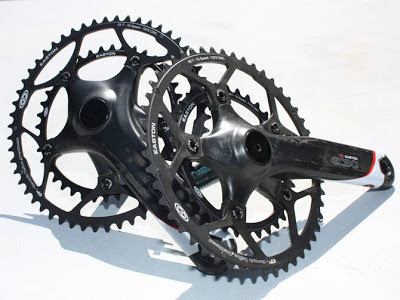
Is compact right for you?
Compact-curious cyclists come from two camps: those riding triples cranksets and those riding standard double cranksets. For many reasons and for many applications, compacts paired with super wide range cassettes (e.g. SRAM WiFLi) are supplanting triple cranksets. This post is mainly addressed to triathletes and cyclists riding standard doubles.
Some sources recommend compact or standard cranksets based on power output. Sometimes 4 W/kg is cited as the threshold above which a standard crankset is a better choice. I don’t see much value in this approach since crankset selection is also a function of preferred cadence, terrain and riding style. For example, although I averaged ~4.5 W/kg in my last Olympic triathlon, I was quite happy with a compact due to the hilly course and my naturally high cadence.
To determine if a compact is right for you, I suggest reading this article, playing with a gearing calculator and observing what gears you actually ride in (as opposed to what’s on your bike). Specifically, are you ever running out of gears, never using certain gears or having to stand to climb every hill?
What are the benefits of compact cranks?
Here are 10 reasons to consider compact cranks:
1. Compacts can provide a wider gear range, especially at the low end. This makes it less likely you’ll run out of gears and be forced into a suboptimal effort level, power output or cadence range (e.g. grinding up a hill). To illustrate this, let’s compare two popular gearing choices: a 53/39 standard crank with a 12-27 cassette and a 50/34 compact crank with an 11-25 cassette. The comparison could be done in terms of gear inches or ratios, but most people find it easier to relate to speed.
Speed at a cadence of 90 rpm*
| Compact | Standard | |
| Top end |
50×11 = 51.5 km/h
|
53×12 = 50.1 km/h
|
|
Bottom end
|
34×25 = 15.4 km/h | 39×27 = 16.4 km/h |
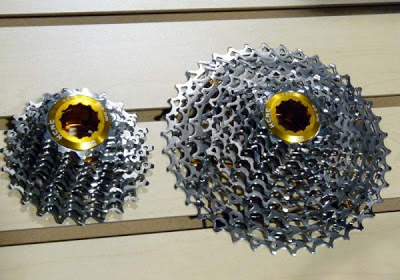
4. Compact setups can have fewer redundant gears compared to standards. Looking at the graph above, you can see that there is less overlap in the ranges covered by the big and small chainrings. This is because compact 50/34 rings have a 16 tooth differential (the max most front derailleurs can effectively accommodate) compared to a 14 tooth differential for standard 53/39 rings.
5. Compacts can improve chainline resulting in improved drivetrain efficiency. Chain drives are very efficient provided the chain runs in a fairly straight line. “Chainline” refers to how straight the chain runs between a chainring and a cassette sprocket. Perfect chainline occurs when the chainring and rear sprocket are in the same plane. The more crooked the path of the chain, the greater the power-sapping frictional losses and wear on drivetrain parts. For this reason, you should avoid certain gearing combinations: big chainring to biggest rear sprocket and small chainring to smaller rear sprockets.
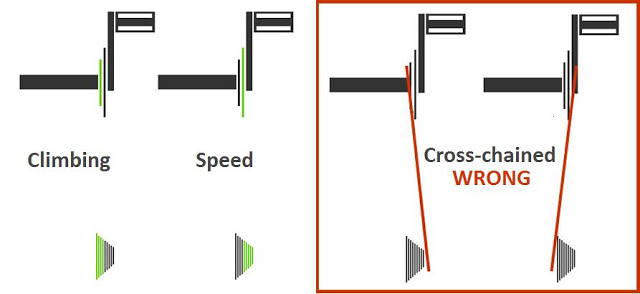
From my own experience and from observing other cyclists, people who are overgeared on standard cranks (i.e. many people) spend too much time in their small chainring and small rear sprockets or even *gasp* cross-chained. Since switching to compact, I’m able to avoid these bad gearing combinations.
6. Related to the previous point, a compact allows you to tackle more terrain in your big chainring meaning less front shifting. This produces less wear on the chainrings, chain and front derailleur. There is also less risk of dropping your chain. An added bonus is that frictional losses are minimized in the big ring because the chain makes a wider radius bend than in the small ring.
7. Compacts are more versatile due to more chainring options. The smallest chainring compatible with standard cranksets is a 38, while compacts can go as low as 33. At the other end of the spectrum, compact chainrings are commonly available in 53 and can be as monstrous as 56 teeth! So you can effectively turn your compact into a standard if need be.
Chainrings can be relatively inexpensive and swapping them only takes a few minutes. It can therefore be practical to have a selection of rings to choose from based on course conditions. For example, 50/34 serves me well for most triathlon courses, but I may opt for 52/36 on a course with a long gradual downhill or tailwind section.
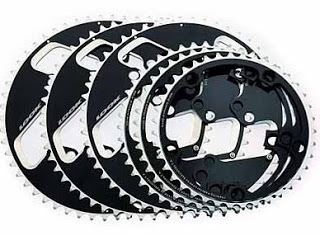
8. Here’s one for triathletes: Compact gearing is conducive to pedaling with a higher cadence which may benefit off-the-bike running. At least one study found that increasing cycling cadence benefited subsequent running performance. But the research is conflicting with other studies finding that a lower cadence benefits running or no relationship between cadence and running performance. One caveat is that the duration of exercise examined in these studies was much shorter than most triathlons (<1 hour). In summary, a higher cadence may improve your off-the-bike running and you should experiment to find out.
9. Compacts are lighter due to the smaller spider, smaller chainrings, shorter chain and potentially smaller cassette. All of these factors could add up to a modest weight savings of 100 grams or more.
10. Compacts may facilitate shorter cranks. There has been a trend towards shorter crank arms among triathletes and time trialists, primarily to allow a lower and more aerodynamic position by opening the hip angle. This, in turn, can lead to improved off-the-bike running. While crank length remains controversial, some studies have shown that its effects on power output or metabolic efficiency are small or insignificant. Assuming this is the case, cyclists are free to choose crank length based on comfort and aerodynamics.
With shorter cranks, some cyclists will naturally choose a higher cadence. Consider this example from Cervelo’s Ask the Engineers series on crank length (recommended reading):
“For example, the difference between 165 and 175 [mm crank arms] is about 5%; some athletes find themselves in a gear about 5% easier than before, with a matching cadence about 5% higher. Coincidentally, the difference between a “compact” 50 tooth chain ring and a 53 is close to 5%.”
However, the opposite may be true for cyclists who do not increase their cadence after switching to shorter cranks. Bike fit guru John Cobb made this rather counter-intuitive observation:
“. . . there was a recurring theme I was noting in my work with athletes: in order for shorter cranks to ‘feel right’ to my riders, they had to start turning bigger gears.” (from Crank Length: Coming Full Circle)
Unfortunately there is no obvious conclusion regarding crank length and gearing. You’ll have to try it out for yourself!
BONUS: Compact gearing may be slightly more aerodynamic due to the smaller chainrings and cassette. Yes, aeroweenies think like that.
If compacts are so great, why isn’t everyone riding them?
There is an unfortunate stigma attached to compact cranks—the idea that they are the wimpy option for weak cyclists. Snobby roadies and bike store employees have been known to sneer at compacts. While some measure their manhood by the size of their big ring, smart cyclists choose equipment based on performance optimization, not vanity. People also like to emulate elite athletes. They want to ride the same frame as their favourite pro, so why not the same crankset? Um…
But compacts definitely aren’t for everyone. Here are some cases when a compact might not cut it:
- You are an exceptionally strong cyclist.
- You prefer a low cadence. Some people are grinders, some are spinners and that’s ok. Experienced cyclists find success with a broad range of cadences. There is no single optimal cadence for every cyclist for every ride (i.e. distance, intensity, elevation profile, etc.).
- Most of your rides involve fast-paced drafting and/or sprinting. Both may require higher gearing.
- You expect to average over 50 km/h for an extended period of time. This may occur on a particular course due to hills or a tailwind. Just keep in mind that you’ll spend even more time pedaling up the hills or into the tailwind (unless it’s a point-to-point course).
- Your bike has 650c wheels, as opposed to the 700c norm. The smaller wheel radius means that you need to push bigger gears to achieve a given speed.
- Your bike isn’t compatible with compact cranksets. Some frames have braze-on front derailleur tabs that are too high to accommodate compact cranks. This is rarely an issue these days.
